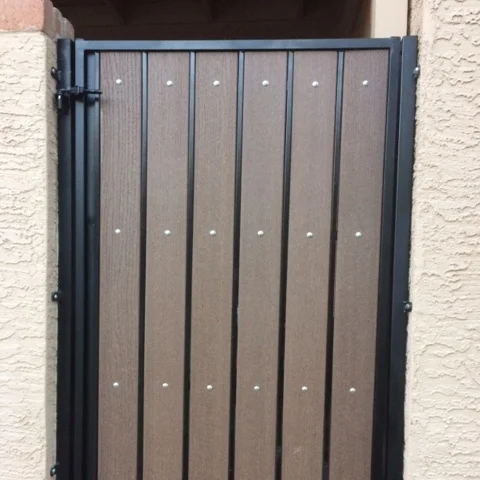Gate Options
A gate, much like a door, creates the feeling of welcoming embrace or stringent security depending on the circumstances. It acts as a portal between your property and the outside world, and sometimes as a transition between parts of your property.
Keeping your security and image needs mind is an essential part of choosing an appropriate gate for the situation. Also, there may be local building codes and HOA regulations which should also be taken into consideration during the selection process.
Whether it’s pets, privacy, security or ease-of-use, think of the big picture when selecting a gate. The gate and fence should work well together. It’s essential to see a variety of options before making a choice, especially if you plan on an electronic or passcode port of entry.
Here are some of the determining factors to consider when choosing a gate:
Pets
Pet security is of supreme interest to not only pet owners, but also neighbors and passersby who may be fearful of your big, fuzzy mutt. If you have a dog who likes to bark, sometimes having good visibility through the gate will agitate the animal if they don’t recognize the person on the other side.
Privacy
Having a privacy fence without a privacy gate is---well, not private. This is why we say that a fence and gate should work well together: in other words, merge the goals of the fence into the goals for the gate.
Security
Secure fences are a thing of beauty when there is an accompanying gate. Without a gate, a fence is nothing more than an impenetrable blockade, which is just as much a prison as it is a deterrent. The height of the gate should be commensurate with the height of the fence and within the restrictions of HOA and building codes.
Ease of use
Ease of use is where enjoyable things happen with gates: Smart gates, electronic options, and other technology can all work together to make the gate user-friendly for those who are welcome without compromising security.
Who needs access
Some of the details of a gate selection beyond the purpose will be related to the number of people who will use the gate and the frequency with which it will be accessed. For example, the local building code requirements for a community swimming pool gate are rather stringent: height, access, etc. But, this is a gate which may need to be accessed by dozens or even hundreds of residents, which means it’s entirely different from the gate requirements of a private swimming pool, which may only provide access for the resident and perhaps the pool cleaning company. So, while a community pool might have an electronic key card option, the back gate of a home with a pool probably won’t.
If you're considering a fence or gate project in the Phoenix area, trust Sereno Custom Fence & Gates. We provide wood fences, block wall fences, iron fences, vinyl fences, chain link fences, composite fences, aluminum fences, temporary fences and custom gates for homeowners in the region. For more information call (602) 481-1298 today!



